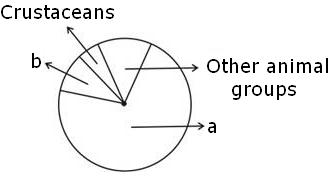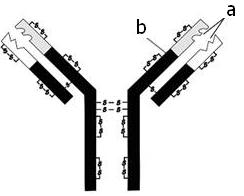Biology:2009:CBSE:[Delhi]:Set-III
To Access the full content, Please Purchase
-
Q1
The microscopic pollen grains of the past are obtained as fossils. Mention the characteristic of the pollen grains that makes it happen.
Marks:1View AnswerAnswer:
Pollen grains of the past are obtained as fossils because of the presence of sporopollenin.
-
Q2

Name the unlabelled areas ‘a’ and ‘b’ of the pie chart (given above) representing the global biodiversity of invertebrates showing their proportionate number of species of major taxa.
Marks:1View AnswerAnswer:
a) Insects
b) Molluscs -
Q3
Name of group of organisms and the substrate they act on to produce biogas.
Marks:1View AnswerAnswer:
Methanogens grow anaerobically on cellulosic material to produce biogas.
-
Q4
Mention the pollinating agent of the inflorescence of small dull coloured flowers with well exposed stamens and large feathery stigma. Give any one characteristic of pollen grains produced by such flowers.
Marks:1View AnswerAnswer:
Wind.
Pollen grains are light and non-sticky so that they can be transported by the wind currents. -
Q5
Some allergens trigger sneezing and wheezing in human being. What causes this type of response by the body?
Marks:1View AnswerAnswer:
It is caused due to allergy which is an exaggerated response of the immune system to certain antigens present in the environment.
-
Q6
Are the thorn of Bouganivillea and tendril of Cucurbita homologous or analogous ? What type of evolution has brought such a similarity in them?
Marks:1View AnswerAnswer:
Thorn of Bouganivillea and tendril of Cucurbita are homologous.
This is an example of Divergent evolution -
Q7
Mention the two additional processings which hnRNA needs to undergo after splicing so as to become functional.
Marks:1View AnswerAnswer:
Capping and tailing are required before a fully functional mRNA is formed.
-
Q8
Which of the following is a free living bacteria that can fix nitrogen in the soil?
Spirulina, Azospirillum, SonalikaMarks:1View AnswerAnswer:
Azospirillum is a free living nitrogen fixing bacteria.
-
Q9
Explain the contribution of Thermos aquaticus in the amplification of a gene of interest.
Marks:2View AnswerAnswer:
Thermostable DNA polymerase is isolated from a bacterium Thermus aquaticus which remain active during the high temperature induced denaturation of double stranded DNA and helps in achievement of repeated amplification.
-
Q10

(i) What does the above diagram illustrate?
(ii) Name the parts labelled ‘a’ and ‘b’.
(iii) Name the type of cells that produce this molecule.Marks:2View AnswerAnswer:
(i) Antibody molecule
(ii) a) Antigen binding site b) Heavy chain
(iii) B-lymphocytes



